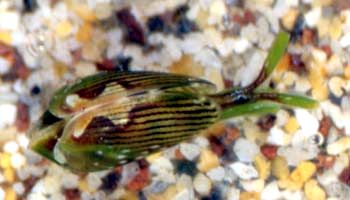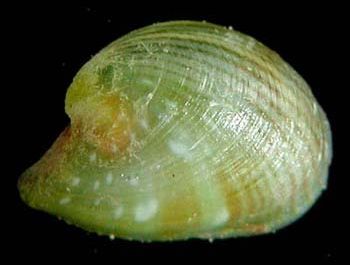

Julia zebra
Kawaguti, 1981
Order: SACOGLOSSA
Superfamily: OXYNOOIDEA
Family: Juliidae
DISTRIBUTION
Japan, Hawaii, Midway Atoll, Raratonga and Magaia (Cook Islands). Probably widespread at least in the tropical Pacific.
PHOTO
Live animal 2.5 mm long, from algae wash at Napili Bay, Maui, Hawaiian Ids, July 3, 1996. Depth less than 1.5 m. Shell 2.9 mm long. From beach drift at Makuleia Bay, Maui in 1983. Photos: Cory Pittman
The color is highly consistent with narrow, continuous brown bands on the anterior portion of the shell and broader, fainter bands on the posterior portion. The bands are superimposed over random white blotches. In live animals, there is extensive brown pigment on the head and rhinophores. The hinge is relatively small and constricted. The central, tooth-like knob is nearly circular in cross section with only a slight indentation on its posterior margin.
It might ultimately turn out to be a synonym of J. thecaphora Carpenter, 1857. Beach-worn shells of that species from the Gulf of California housed at the California Academy of Sciences appear indistinguishable from Hawaiian shells of J. zebra.
[See separate messages for details of Hawaiian records and the shell]
Reference:
• Kawaguti, S (1981) A new bivalved gastropod Julia zebra. Bulletin of the Kawasaki Paramedical College, 1: 9-13.
Pittman, C., 2001 (October 10) Julia zebra Kawaguti, 1981 . [In] Sea Slug Forum. Australian Museum, Sydney. Available from http://www.seaslugforum.net/find/julizebr
Related messages
Hawaiian Julia zebra
October 12, 2001
From: Cory Pittman


On Maui, shells of Julia zebra Kawaguti, 1981 are common in sand samples that include material from shallow, moderately exposed to exposed, rocky habitats. However, unlike J. exquisita and Julia sp. 1 they are also common in samples that include material from moderately protected, back-reef habitats. All told, I've seen several thousand valves with a maximum shell length of 3.4 mm. I've also picked up about 73 live animals in algae washes from depths of less than 1 m to 15 m (most of my washes have been in moderately protected areas). The color is highly consistent with narrow, continuous brown bands on the anterior portion of the shell and broader, fainter bands on the posterior portion. The bands are superimposed over random white blotches. In live animals, there is extensive brown pigment on the head and rhinophores. The hinge is relatively small and constricted. The central, tooth-like knob is nearly circular in cross section with only a slight indentation on its posterior margin. [See separate message for detailed photos of shells].
Although not a synonym of J. exquisita, it might ultimately turn out to be a synonym of J. thecaphora Carpenter, 1857. Beach-worn shells of that species from the Gulf of California housed at the California Academy of Sciences appear indistinguishable from Hawaiian shells of J. zebra.
I've found shells in sand samples (sent to me by Pauline Fiene-Severns and Jerry Flora) from Abemama Atoll, Midway Atoll, Raratonga and Magaia(Cook Islands).
The live shot is of a 2.5 mm animal collected in an algae wash at Napili Bay, Maui on July 3, 1996. It was at a depth of less than 1.5 m. The hint of blue on the eyes is an artifact of lighting. The shell photos are of a closely matched (though slightly worn) pair 2.9 mm in length. They were in a sand sample collected from beach drift at Makuleia Bay, Maui in 1983.
Cory Pittman
cory@cet.com
Pittman, C., 2001 (Oct 12) Hawaiian Julia zebra. [Message in] Sea Slug Forum. Australian Museum, Sydney. Available from http://www.seaslugforum.net/find/5374Shell of Julia zebra
October 12, 2001
From: Cory Pittman

Here are detailed shell photos of Julia zebra from Hawaii to accompany my earlier message.
On Maui, I've seen several thousand valves with a maximum shell length of 3.4 mm. The color is highly consistent with narrow, continuous brown bands on the anterior portion of the shell and broader, fainter bands on the posterior portion. The bands are superimposed over random white blotches. The hinge is relatively small and constricted. The central, tooth-like knob is nearly circular in cross section with only a slight indentation on its posterior margin.
I've found shells in sand samples (sent to me by Pauline Fiene-Severns and Jerry Flora) from Abemama Atoll, Midway Atoll, Raratonga and Magaia(Cook Islands).
The shell photos are of a closely matched (though slightly worn) pair 2.9 mm in length. They were in a sand sample collected from beach drift at Makuleia Bay, Maui in 1983.
Cory Pittman
cory@cet.com


